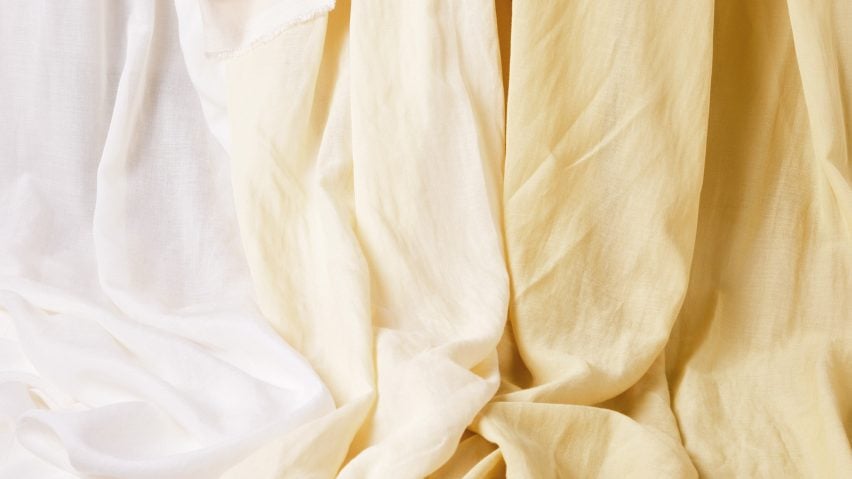British textile brand Kirkby Design has created what it believes to be the first interior fabric made from aloe vera – a plant that grows without need for chemicals, fertilisers or additional watering.
Kirkby Design's Aloe fabric is a sheer, washable, wide-width drapery textile made of 60 per cent aloe vera and 40 per cent organic cotton.
The brand says the fabric is more sustainable than conventional textiles because the aloe requires no pesticides and uses less water during cultivation than other plants, especially cotton. It also utilises waste leaves that accumulate as a byproduct of extracting aloe vera gel for the cosmetics industry.
Kirkby Design director Jordan Mould said that aloe vera has unique light-filtering properties, which the brand took advantage of to produce a sheer curtain.
"Aloe Vera's natural structure allows the yarn to create fabrics that have a lightweight, airy quality," Mould told Dezeen. "Aloe fabric allows light to filter through gently, creating soft, diffused lighting within a room."
"This gives spaces an ethereal, contemporary glow without sacrificing privacy. It's ideal for creating sheer or semi-sheer fabrics that maintain a balance between openness and privacy."
Mould said that the idea to use aloe vera came after researching plant-based fibres that could reduce the company's environmental impact while still offering high performance and aesthetic qualities.
One of the textile mills Kirkby Designs works with approached the brand with the proposal to use aloe vera and the two companies collaborated to develop the yarn together.
The process involves working with the leaves of the aloe vera plant after their gel has been extracted for use in other industries. The leaves are pressed, shredded and spun into a fleece-like material that is then spun into yarn.
"The R&D process took considerable time as we had to perfect the fibre's weight, texture and colour, ensuring it met the standards we set for both sustainability and performance," said Mould.
"The resulting yarn not only offers a soft, luxurious touch but also performs exceptionally well, making it suitable for both aesthetic and practical applications."
Kirkby Design is making the fabric available in a range of neutral shades and vivid colours like Acid Yellow and Cobalt Blue, which make use of another property of the aloe vera fibre: its excellent dye absorption.
The company says that the dyeing process, like the textile's entire production process, is relatively low in chemical usage, and is REACH and Oeko-Tex certified to be free from harmful substances such as heavy metals, formaldehyde and azo dyes.
Mould believes aloe vera has the potential to be used much more widely in textile production, as it can yield a variety of different looks.
"Its adaptability allows it to be blended with other fibres, creating fabrics that can vary widely in texture, appearance and functionality," said Mould.
"Much like hemp and bamboo, we see aloe vera carving out a significant role in the industry, offering a sustainable alternative to more traditional fibres while maintaining a wide range of aesthetic possibilities."
Aloe vera has already been used to make fabric for clothing and bedding but these have predominantly contained only small quantities of the plant, often in the form of microencapsulated gel.
Kirkby Design's Aloe is a shortlisted entrant in this year's Dezeen Awards, in the textile design and sustainable consumer design categories.
Other recent low-impact material innovations have included RePit, a 3D-printing filament made from waste date pits, and Aquafade, a water-soluble plastic.

